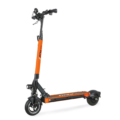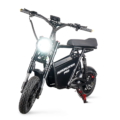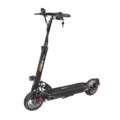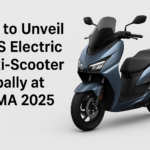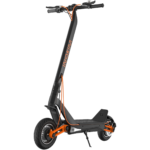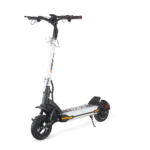- Home
- Scooters
- Electric Scooters
- EMOVE RoadRunner V2
EMOVE RoadRunner V2
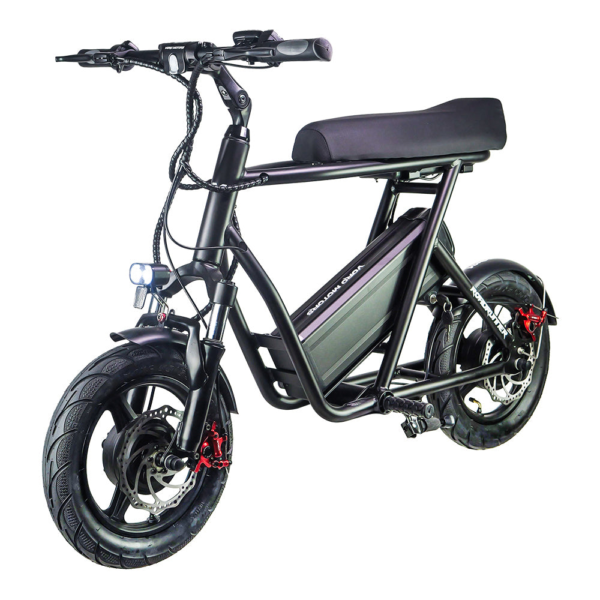

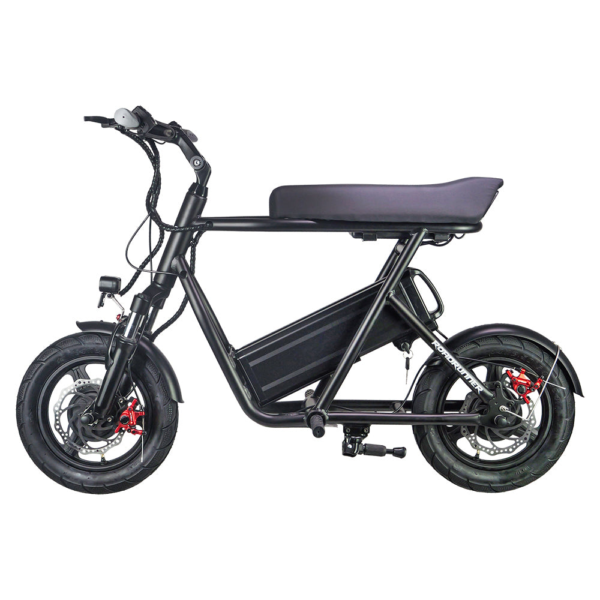
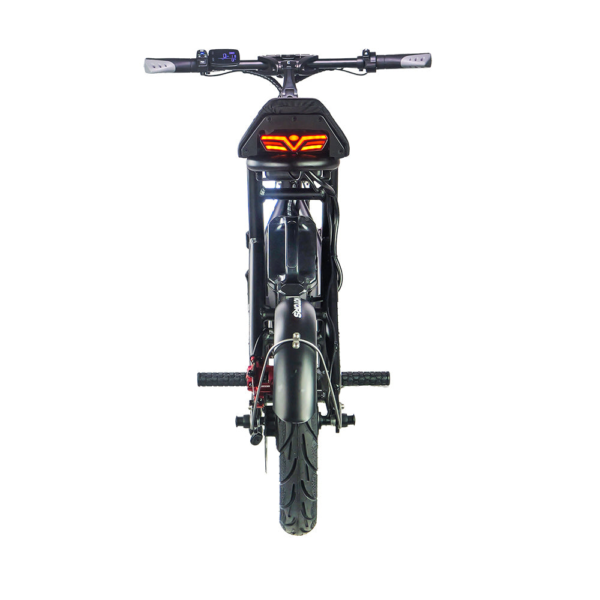
- Battery Range: 50 miles (80 km)
- Top Speed: 32 mph (51 km/h)
- Motor Power: 350W front + 500W rear
- Weight Capacity: 330 lb (149.7 kg)
- Charging Time: 9 hours
- Scooter Weight: 55 lb (24.9 kg)
PROS
- 50 mi (80 km) range
- Dual hub motors (350W + 500W)
- 14″ tubeless tires
- XTECH hybrid hydraulic brakes
- Swappable, lockable battery
CONS
- No official IP rating
- Front-only suspension
- Doesn’t fold (frame)
Key Takeaways
- The EMOVE RoadRunner V2 is a seated, dual-motor scooter with a removable battery and 14-inch tubeless tires.
- It offers a smooth ride with features like hybrid hydraulic brakes and an adjustable front suspension.
- Riders can expect a range of up to 50 miles, and the battery swaps easily for longer distances.
- The scooter supports a comfortable commuting experience, while its build quality ensures stability and durability.
- Ideal for daily commuters, students, and multi-modal travelers, but less suited for those needing high-speed performance on steep grades.
Table of contents
- What Is the EMOVE RoadRunner V2?
- How the EMOVE RoadRunner V2 Works
- Key Specifications
- Design & Build Quality
- Performance Fundamentals
- Battery, Range & Efficiency
- Ride Quality & Comfort
- Braking & Safety Features
- Portability & Daily Usability
- Maintenance & Care
- Weather & Seasonal Considerations
- EMOVE RoadRunner V2 vs Alternatives
- Who the EMOVE RoadRunner V2 Is (and Isn’t) For
- FAQs
- Glossary
- Quick setup and safety notes
The EMOVE RoadRunner V2 is a seated, dual-motor scooter made for real daily miles. It mixes a 48 V 26 Ah removable battery, 14-inch tubeless tires, and hybrid hydraulic brakes. So it fits riders who want solid range, a comfy seat, and easy storage without jumping to a full-size e-bike. And when your day runs long, a quick battery swap keeps the ride going. If you want a lighter sibling or more power, take a look at the EMOVE RoadRunner SE and the EMOVE RoadRunner Tronic.
What Is the EMOVE RoadRunner V2?
Think compact “mini-moto” with two hub motors, folding handlebars, and a long memory-foam seat. You sit low, rest your feet on folding pegs, and steer with a straight bar that carries a thumb throttle and simple LCD. Weight sits near the ground, so the frame feels calm over cracks and painted lines. Then the removable battery locks in the center triangle, which helps balance and makes swaps painless.
The power system pairs a 350 W front hub with a 500 W rear hub. You can cruise in single-motor mode or tap both motors for quicker starts and better hill holds. A square-wave controller feeds power in a smooth arc, not a harsh jump. So throttle pickup feels friendly in parking lots and across campus. Meanwhile, XTECH hybrid hydraulic disc brakes give firm bite with light lever effort.
The chassis uses 6061 aluminum alloy and feels sturdy. The V2 update adds tubeless tires, brighter lights, and small tweaks like longer pegs and a tighter bar latch. So it reads like a commuter first, yet it stays playful for short weekend loops.
How the EMOVE RoadRunner V2 Works
It runs like a compact, sit-down runabout. Power it on, sit, and press the thumb paddle for speed. The controller reads your input and pushes current to one or both motors. So acceleration builds in a steady, predictable way. Then the LCD shows speed, mode, and battery.
The 48 V pack slides out from the center of the frame. You can charge it on the scooter or bring it inside. City living gets easier, since the pack locks with a key and pops out by a handle. Braking stays simple. Hybrid hydraulic calipers boost a cable pull, so you get good power without a heavy squeeze.
Lighting covers common needs. A bright headlight helps you see and be seen. Then the rear carries a brake light and turn signals for clear calls in traffic. The 14-inch tubeless tires hold more air than typical scooter rubber. So bumps feel smaller, grip rises on rough patches, and the risk of pinch flats drops.
Key Specifications
Values reflect official listings and widely published data for the V2. Imperial and metric units appear together for quick checks. This section uses the word specifications as a clear label.
General
| Item | Value |
|---|---|
| Model | EMOVE RoadRunner V2 seated electric scooter |
| Frame material | 6061 aluminum alloy |
| Scooter weight | 55 lb (24.9 kg) |
| Max rider load | 330 lb (150 kg) |
| Tire type & size | 14 in tubeless pneumatic, ~2.5 in width (36 cm diameter, ~6.35 cm width) |
| Seat | Memory-foam, ~14 × 8 in (35.6 × 20.3 cm) |
| Handlebar | Folding, anti-glare LCD, adjustable height |
Performance & Power
| Item | Value |
|---|---|
| Motors | Front 350 W, rear 500 W hub motors |
| Peak output | ~720 W front, ~960 W rear |
| Top speed | Up to 32 mph (52 km/h) |
| Hill climb | Short grades around ~17° on brief ramps |
| Drive modes | Single- or dual-motor |
| Throttle | Thumb throttle |
Battery, Charging & Electrical
| Item | Value |
|---|---|
| Battery | 48 V 26 Ah Dynavolt, ~1,253 Wh |
| Range (per pack) | Up to ~50 mi (80–85 km), route and rider dependent |
| Swappability | Lockable, slide-out pack with handle |
| Charger | 54.6 V, ~3 A |
| Charge time | ~9 hours from low |
| Display | LCD with mode and trip readouts |
| Lights | Bright headlight, rear brake light, rear turn signals |
Build & Dimensions
| Item | Value |
|---|---|
| Unfolded size | 50 × 25 × 38 in (127 × 63.5 × 96.5 cm) L × W × H |
| Folded dimensions | Handlebars fold; frame length stays ~50 in (127 cm) |
| Handlebar width | ~25 in (63.5 cm) |
| Handlebar height range | ~32–38 in (81–97 cm) |
| Ground clearance | ~8 in (20.3 cm) |
| Peg reach | ~18 in (45.7 cm) from upper chassis |
Safety & Control
| Item | Value |
|---|---|
| Brakes | XTECH hybrid hydraulic disc, front and rear |
| Tires | 14 in tubeless pneumatic |
| Water use | Light rain riding; avoid standing water |
| Signals | Rear turn signals and brake light |
| Headlight | High-output, anti-glare housing |
Features & Extras
| Item | Value |
|---|---|
| Battery | Swappable, lockable pack |
| Cockpit | Folding bars, anti-glare LCD, tactile switches |
| Suspension | Adjustable front spring fork with ABS+-style damper |
| Comfort | Longer memory-foam seat; longer foot pegs |
| Mounts | Center triangle space for small bags |
Warranty & Compliance
| Item | Value |
|---|---|
| Warranty | 1-year limited warranty (brand standard) |
| Compliance | Local rules differ by region; check allowed paths and speeds |
Design & Build Quality
The RoadRunner V2 feels sorted. The welded frame keeps the heavy bits low and centered, so the scooter stays steady over rough paint and small gaps. The long seat spreads pressure and cuts hot spots on longer stretches. You can slide forward for tight turns, then scoot back for straight-line comfort.
Finish quality looks clean. The bar folds inward with a firm latch and locks tight when raised. The LCD stays readable in direct sun, and the buttons sit close to your thumbs. Cable runs keep close to the fork, so nothing snags at full lock.
Metal pegs flick out with a crisp stop. Your feet land in the same spot every time, which helps when you roll off a curb or brake hard. The front fender runs longer now, and the rear sits lower over the tire. So spray stays down on damp streets. Tubeless tires round out these upgrades with fewer pinch flats and the option to run a touch less pressure for comfort.
Performance Fundamentals
Starts feel smooth and easy to place. In single-motor mode, slow moves stay calm, which helps in garages and tight bike racks. Switch to both motors, and the scooter pulls with steady force to city speeds. So short merges and quick crossings feel natural. The thumb throttle gives fine control through the first half of its throw, which helps in crowded areas.
Straight-line stability is a strong point. The longer wheelbase and 14-inch tires track well over road crown and weathered paint. For example, the bar stays quiet at practical speeds when tire pressure sits in the mid-30s psi. The tubeless casing and revised tread also shrug off tiny gravel and leaf dust better than thin 10-inch setups.
Hills are realistic for this size. On 7–10% grades, the scooter holds speed better with both motors on. Then, near the top of steeper ramps, you may feel a slow-down as voltage sags under load. A short run-up helps, and a centered body keeps the front tire hooked up. For daily climbs of moderate length, the power mix feels right.
Battery, Range & Efficiency
The 48 V 26 Ah pack stores about 1.25 kWh. So it sits in a sweet middle for a seated scooter. Many riders see 25–40 miles (40–64 km) on mixed routes at steady pace. Lighter riders on flat paths may stretch that number. Heavier riders with frequent stops and hills land lower. Wind, temperature, and tire pressure nudge the result, too.
Pack swaps are quick. Turn the key, pull the handle, and slide the pack free. Then a fresh pack drops in with a solid click. For daily charging, the ~3 A brick takes a near-empty pack to full in about nine hours. Overnight top-ups fit most schedules.
Simple habits add life. Charge soon after rides instead of letting the pack sit near empty. Store indoors at room temperature. If you will park it for a week or more, leave the battery around mid charge. Keep the charge port cap clean and closed between sessions. These small steps pay off over time.
Ride Quality & Comfort
The V2 rides softer than many stand-up scooters in the same weight class. The long, padded seat spreads pressure and gives your hands a break. The front fork adds a layer of bump control, and you can dial it firm for smooth streets or soft for broken pavement. So the scooter adapts to your route and your weight.
Tires do a lot of work here. The 14-inch size rolls past cracks that catch 8.5 or 10-inch wheels. At 30–40 psi, the casing itself acts like a small spring. So you gain comfort without a complex rear linkage. The low center of gravity helps, too. The scooter leans in with a steady feel, and mid-corner ripples shake the bar less.
Bar and stem flex stay modest at city speeds. The latch locks tight, and the short stem resists twist under braking. Steering feels direct when you trail the rear brake into a tight turn. On rough patches, a light grip keeps the bar from shimmying. Once the surface cleans up, the scooter tracks straight again.
Braking & Safety Features
The XTECH hybrid hydraulic setup boosts a standard cable pull. Lever travel stays short, and bite arrives near mid-stroke. You can adjust pad clearance at the caliper as pads wear. Two rotors share the heat on long drops. For a 55 lb frame, that mix delivers confident stops.
Lights cover day and night needs. The headlight throws a bright white beam. Aim it low so you do not glare other riders. The rear adds a brake light and amber signals. Hand checks plus signals send a clear message in mixed lanes. The bar height also pairs well with small mirrors if you want a steady rear view.
Water deserves respect. Light drizzle is one thing. Heavy rain and standing water cut grip and range. Slow earlier, lengthen brake zones, and steer around metal plates and painted lines when wet. Then dry the scooter once you are home with a towel and a small fan.
Portability & Daily Usability
At 55 lb (24.9 kg), short lifts are fine, yet it is not a shoulder carry. The easiest move is to grab the frame near the battery handle and lift with your legs. Folding bars save width, so doorways and elevators feel easy. Length stays around 50 inches, so plan floor space if you store it inside.
Daily security works best in layers. Lock the frame to a fixed rack with a hardened U-lock or chain. Then bring the battery inside when you can. For apartments, use a covered entry or garage corner. A small mat under the tires keeps grit off the floor and makes cleanup simple.
Errands fit the layout well. A compact frame bag in the center triangle holds tools, lunch, or a light jacket. Weight rides low and near center, so steering stays neutral. For bigger loads, a backpack gets it done and leaves the triangle open for airflow.
Maintenance & Care
A short checklist keeps the RoadRunner V2 ready.
Before each ride
- Check tire pressure. Start at 35–40 psi, then tweak a few psi for comfort or grip.
- Squeeze both levers. You want firm bite and quiet rotors.
- Scan both tires for cuts or embedded grit.
- Confirm the battery locks in place and the key moves smoothly.
Weekly
- Wipe the frame and wheels with a damp cloth. Dirt hides damage and holds moisture.
- Check rotor bolts and caliper mounts for snug fit.
- Inspect the peg pivots and bar latch. Add a tiny drop of light oil if movement feels dry.
Monthly
- Inspect brake pads. Replace them when friction material reaches ~1 mm.
- Check headset play by holding the front brake and rocking the bar. Tighten if you feel a knock.
- Look over the charging port and cap for dust. Clean gently and close the cap.
Battery habits
- Charge after rides rather than letting the pack sit low.
- Store indoors near 50–77 °F (10–25 °C).
- If you will park it for a while, leave the pack around mid charge.
- Keep rails and contacts clean and dry.
Display and settings
- The V2 uses a simple LCD with rider-level settings. Jot your defaults in a phone note, then restore them quickly after a reset.
Weather & Seasonal Considerations
Rain trims range and grip. Ride a bit slower, brake earlier, and avoid standing water. Then dry the scooter when you get home. Heat matters too. On very hot days, the pack may run warm, and the controller may trim output to protect parts. Park in the shade when you can, and start the ride at moderate pace.
Cold weather shortens range. Expect a softer pull for the first mile. Ease into the ride while the battery warms. Tire pressure shifts with temperature as well. For example, a drop from 75 °F to 45 °F can shave a few psi. Check pressures more often in winter.
Road salt speeds corrosion. Wipe the frame, pegs, rotors, and bolts after salted rides. A quick clean keeps hardware looking fresh.
EMOVE RoadRunner V2 vs Alternatives
Against stand-up commuter scooters, the RoadRunner V2 trades a fast fold for comfort and range. You sit down, carry the battery low, and roll on 14-inch tires. So the scooter feels calmer at speed than many 10-inch models. If your day includes lots of stairs or very tight storage, a lighter stand-up still wins.
Compared with compact e-bikes, the V2 takes up less space and keeps service simple. It weighs less than many small bikes and fits in tighter corners indoors. Hub motors also skip chain and gear wear. You do give up true pedal backup and classic racks. If trains in your city favor pedal bikes, a folding bike could still be tempting.
Next to large performance scooters, the V2 leans toward range and comfort over peak speed. It will not match heavy 40+ mph builds. If your route sits on fast arterials, a bigger chassis may suit that job. For mixed paths, side streets, and campus loops, this one hits a nice middle.
Who the EMOVE RoadRunner V2 Is (and Isn’t) For
Great for
- Daily commuters who prefer to sit, carry a backpack, and ride 5–20 miles each way.
- Students who cross campus and want calm manners at legal speeds.
- Riders who want a quick-swap battery and steady handling on patchy pavement.
- Multi-modal travelers who store a scooter at work or in elevators.
Less ideal for
- Riders who climb long, steep grades and expect high speeds at the top.
- People who carry a scooter up several flights every day.
- Anyone who wants a true pedal bike feel with racks and baskets.
FAQs
How fast is the EMOVE RoadRunner V2?
Top speed sits around 32 mph (52 km/h) in stock form. So short merges feel simple, and city pacing stays relaxed.
What real-world range should I expect?
On mixed routes, many riders see 25–40 miles (40–64 km). Weight, speed, stops, and hills nudge the final number. A small buffer helps in wind or cold.
Can I swap the battery during the day?
Yes. The pack slides out with a key and handle. You can charge a spare while you ride or keep one ready for the trip home.
Is the front suspension adjustable?
It uses an ABS+-style damper with a dial. Turn it firm for smooth streets or soft for broken pavement.
Does it have cruise control?
The display focuses on core data. Most owners ride without cruise and lean on the smooth thumb throttle for steady pace.
What tire pressures work best?
Start at 35–40 psi. Then tweak a few psi for comfort or grip based on weight and route.
Where can I find a full “EMOVE RoadRunner V2 overview”?
You are reading it now. This guide covers design, power, handling, care, and setup tips in one place.
Glossary
Ah (amp-hours)
Battery capacity. Higher Ah means more stored charge.
Wh (watt-hours)
Energy content. Multiply voltage by amp-hours to estimate.
Controller
Electronics that meter current from the pack to the motors.
Hub motor
A motor built into the wheel hub that drives the wheel directly.
Square-wave controller
A control style that delivers smooth, predictable power for daily rides.
Thumb throttle
A small paddle you press with your thumb to set speed.
Regen
Electronic braking that feeds a small amount of energy back to the pack. Some simple systems blend it lightly with mechanical brakes.
Semi-hydraulic (hybrid) brakes
A cable lever runs a caliper with hydraulic assist for stronger bite.
Tubeless tire
A tire that runs without a tube. With sealant, it can self-seal small punctures.
Stem flex
Side movement felt at the bar. Less flex gives a more direct steering feel.
IP rating
Ingress rating for dust and water. This scooter lists light-rain use rather than a specific code.
Hill grade
Road slope in percent or degrees. A 10% grade rises 10 meters over 100 meters.
PSI
Pounds per square inch. A common tire-pressure unit.
State of charge (SoC)
How full the battery is, shown as a percent.
Square-profile tire
A casing shape with a broader patch that helps straight-line stability and brake feel.
Quick setup and safety notes
Set the bar so your elbows keep a slight bend. Angle the levers in line with your forearms. Aim the headlight low enough to avoid glare. Wear a helmet every ride. Local rules vary, so learn the posted limits where you live.
A small home kit helps a lot: 4/5/6 mm hex keys, a T25 for rotors, cable cutters, spare pads, and a floor pump with a gauge. Add a plug kit or sealant for fast fixes. A bright clip-on rear flasher boosts daytime visibility.
Specifications
General
| Model The Model specifies the exact version or name of the scooter. It helps identify its unique design, features, and specifications within the manufacturer’s product line. Knowing the model makes it easier to compare options, find compatible accessories, or look up support information. | RoadRunner V2 |
| Brand The Brand identifies the manufacturer or company that designs and produces the scooter. A trusted brand is a sign of quality, reliability, and good customer support. Well-known brands often have higher standards for safety, performance, and after-sales service, giving you more confidence in your purchase. | EMOVE |
| Release Date The Release Date indicates when the scooter model was officially launched on the market. This helps you know how current the design, technology, and features are. A newer release date often means updated components, improved performance, and the latest safety or smart features. | 18 November 2025 |
| Recommended Age Recommended Age indicates the minimum age range that the scooter is designed for, based on safety, size, and ease of use. Following the recommended age helps ensure that riders can handle the scooter’s speed, weight, and controls comfortably and safely. Always check local laws and use protective gear, especially for younger riders. | +16 |
Performance & Power
| Motor Power (Wattage) What it means: The motor power, measured in watts (W), shows how strong the scooter’s electric motor is. Why it matters: Higher wattage usually means better acceleration, more torque, and improved performance on hills or rough terrain. For example, a 250W motor is good for flat city roads and light riders, while a 500W or 1000W motor provides more power for faster speeds or climbing steep inclines. | Dual hub motors (350W front + 500W rear) |
| Top Speed The Top Speed indicates the maximum speed that the scooter can reach under optimal conditions. It’s usually measured on level ground with a fully charged battery and an average rider weight. A higher top speed allows you to travel longer distances faster, but always ensure you ride within legal speed limits and your personal comfort zone for safety. | 32 mph (51 km/h) |
| Battery Capacity Battery Capacity refers to the total amount of energy the scooter’s battery can store, usually measured in ampere-hours (Ah) or watt-hours (Wh). A higher battery capacity means you can ride longer distances on a single charge, reducing the need for frequent recharging. Keep in mind that actual range can vary depending on rider weight, terrain, speed, and weather conditions. | 48 V 26 Ah (1,253 Wh) |
| Estimated Range per Charge The Estimated Range per Charge indicates the average distance the scooter can travel on a single full battery charge. This range is calculated under optimal conditions, such as flat terrain, moderate speed, and average rider weight. Real-world range may vary depending on riding style, terrain, weather, and load. A longer range means fewer recharges and greater freedom for longer trips. | 50 miles (80 km) |
| Hill Climb Ability Hill Climb Ability describes the maximum incline or slope that the scooter can handle while maintaining stable performance. It’s typically expressed as a percentage or in degrees. A higher hill climb rating means the scooter can tackle steeper hills without losing too much speed or power. Actual climbing performance may vary based on rider weight, battery charge, and terrain conditions. | 17° |
| Drive System The Drive System refers to how power from the motor is delivered to the wheels. Electric scooters typically use either a hub motor (directly integrated into the wheel) or a chain/belt drive system. A high-quality drive system ensures smooth acceleration, efficient power transfer, and low maintenance. The choice of drive system affects performance, noise level, and overall ride experience. | 2WD (front+rear hub) |
Charging & Electrical
| Charging Time Charging Time indicates how long it takes to fully recharge the scooter’s battery from empty to 100% using the standard charger provided. Faster charging means less downtime and more time on the road. Actual charging time may vary slightly depending on battery capacity, charger output, and environmental conditions. | 9 hours |
| Battery Type Battery Type refers to the specific technology used in the scooter’s battery, which affects performance, lifespan, weight, and charging time. Most modern electric scooters use high-quality lithium-ion (Li-ion) batteries because they offer a good balance of energy density, durability, and low maintenance. A reliable battery type ensures consistent power delivery and longer riding ranges. | Lithium-ion pack with BMS |
| Removable Battery A Removable Battery means the battery pack can be easily detached from the scooter for convenient charging and replacement. This feature allows you to charge the battery separately, swap it with a spare for extended range, or securely store it indoors in extreme weather. Removable batteries add flexibility and make it easier to keep your scooter powered up wherever you are. | Yes |
| Regenerative Braking Regenerative Braking is an energy-saving feature that converts some of the energy normally lost during braking back into battery power. When you slow down or brake, the motor works in reverse to generate electricity, which helps extend the scooter’s range and improves overall efficiency. This system also reduces wear on traditional brake components, leading to lower maintenance over time. | Not specified |
| Lighting Lighting refers to the built-in front and rear lights that enhance visibility and safety when riding in low-light conditions or at night. Good lighting helps you see the road ahead and ensures that other road users can see you. Many scooters include LED headlights, taillights, and sometimes brake lights or side reflectors for added safety and compliance with local traffic regulations. | LED headlight, rear brake + turn signals |
Build & Dimensions
| Scooter Weight Scooter Weight refers to the total weight of the scooter when fully assembled, including the battery. This affects how easy it is to carry, lift, and store the scooter when not in use. A lighter scooter is more portable and convenient for commuting, especially if you need to carry it upstairs or onto public transport. Keep in mind that a sturdy frame and quality components may add to the weight but also contribute to better durability and ride stability. | 55 lb (24.9 kg) |
| Maximum Rider Weight Maximum Rider Weight indicates the highest rider weight that the scooter is designed to safely support while maintaining optimal performance and stability. Staying within this limit helps ensure reliable acceleration, braking, and climbing ability, and it protects the frame, suspension, and motor from excessive strain. Exceeding the recommended limit may reduce performance and increase wear on components. | 330 lb (149.7 kg) |
| Deck Size Deck Size refers to the dimensions of the scooter’s standing platform. A wider and longer deck provides more foot space, allowing you to stand comfortably and adjust your stance while riding. A well-sized deck improves balance and stability, especially on longer rides or at higher speeds. Compact decks, on the other hand, help keep the scooter lightweight and portable. | Seated mini-bike style; folding handlebars |
| Handlebar Height Handlebar Height refers to the distance from the deck to the handlebars, which affects your riding posture and comfort. An appropriate handlebar height helps you maintain good balance, reduces strain on your back and arms, and makes steering more comfortable. Some scooters have adjustable handlebars to fit riders of different heights, while others have a fixed height for a streamlined design. | Adjustable |
| Folding Mechanism The Folding Mechanism describes how easily and securely the scooter can be folded for carrying and storage. A well-designed folding system lets you quickly collapse the scooter into a compact size, making it convenient to transport on public transit, store under a desk, or fit into a car trunk. Look for sturdy latches and safety locks to ensure the scooter stays firmly in place when folded or unfolded. | Folding handlebars; fixed frame |
| Dimensions Folded Dimensions indicate the size of the scooter when it’s fully folded. This measurement shows how much space the scooter will take up when stored or carried, making it easier to check if it will fit in your car trunk, under a desk, or in a closet. Compact folded dimensions are ideal for commuters who need to bring their scooter on public transport or store it in tight spaces. | Unfolded: 50" (L) x 25" (W) x 38" (H); Folded: Not specified |
| Material Material refers to the primary construction materials used for the scooter’s frame and key components. High-quality materials like aircraft-grade aluminum, reinforced steel, or durable composites provide strength, stability, and a lighter overall weight. A sturdy material ensures the scooter can handle daily wear and tear while maintaining safety and performance. | 6061 aluminum alloy |
Safety & Control
| Brake Type(s) Brake Type(s) describe the braking systems the scooter uses to help you slow down or stop safely. Common brake types include mechanical brakes (like drum or disc brakes), electronic brakes, and foot brakes. Many scooters combine multiple braking systems for added safety and shorter stopping distances. The type and quality of brakes affect your control, especially when riding at higher speeds or on slopes. | XTECH hybrid hydraulic discs (front & rear) |
| Suspension Suspension refers to the system that absorbs shocks and vibrations while riding, providing a smoother and more comfortable ride over uneven or rough surfaces. Scooters may have front suspension, rear suspension, or dual suspension for better shock absorption and stability. Good suspension helps reduce rider fatigue and improves control, especially when riding on bumpy roads or off-road paths. | Front suspension; rear: none |
| Tire Type Tire Type refers to the kind of tires the scooter uses, which directly affects ride comfort, traction, and maintenance. Common types include solid (airless) tires, pneumatic (air-filled) tires, or hybrid options. Pneumatic tires offer better shock absorption and a smoother ride on rough surfaces, while solid tires are puncture-proof and require less upkeep. The right tire type helps ensure safe handling and a comfortable ride in different conditions. | 14" tubeless pneumatic |
| Tire Size Tire Size indicates the diameter and width of the scooter’s tires, which affect ride comfort, stability, and how well the scooter handles different terrains. Larger tires generally offer better shock absorption and a smoother ride over bumps and rough surfaces, while smaller tires keep the scooter lighter and more portable. Choosing the right tire size helps ensure a balance between agility and comfort. | 14-inch |
| Kickstand The Kickstand is a built-in stand that allows you to park your scooter upright when it’s not in use. A sturdy kickstand keeps the scooter stable and prevents it from tipping over, protecting it from scratches and damage. It also makes storing and accessing your scooter more convenient, whether you’re at home, work, or on the go. | Side kickstand |
| Water Resistance Rating Water Resistance Rating indicates how well the scooter is protected against water and moisture, usually shown as an IP (Ingress Protection) rating. This rating helps you understand whether the scooter can handle light rain, splashes, or wet roads without damage. While most scooters are not fully waterproof, a good water resistance rating adds peace of mind when riding in changing weather conditions. Always avoid deep puddles or submerging the scooter to protect its electrical components. | Not specified |
Features & Extras
| Display/Console The Display (or Console) shows important real-time information about your ride, helping you monitor your scooter’s status at a glance. Typical displays show speed, battery level, distance traveled, and riding mode. Some models also include additional features like Bluetooth connectivity, app integration, or backlighting for better visibility at night. A clear and easy-to-read display enhances safety and convenience on every trip. | LCD display |
| Ride Modes Ride Modes refer to the different speed and power settings you can choose to match your riding style or road conditions. Common modes include eco for maximum range and energy efficiency, standard for everyday balance, and sport or turbo for higher speed and stronger acceleration. Switching between ride modes allows you to customize performance, conserve battery, and ride safely in various environments. | 3 modes (single/dual) |
| Smart App Connectivity Smart App Connectivity lets you pair your scooter with a dedicated mobile app via Bluetooth. Using the app, you can monitor real-time ride stats like speed, battery level, and range, adjust settings such as ride modes or cruise control, lock the scooter for added security, and sometimes receive firmware updates. This feature adds convenience and allows you to personalize your riding experience right from your smartphone. | None |
| Anti-Theft System The Anti-Theft System helps protect your scooter from unauthorized use or theft. This feature can include built-in alarms, electronic motor locks, GPS tracking, or remote locking through a mobile app. A good anti-theft system provides peace of mind when parking your scooter in public spaces, adding an extra layer of security to safeguard your investment. | Keyed battery lock |
| Cruise Control Cruise Control allows you to maintain a steady speed without continuously holding the throttle. This feature makes longer rides more comfortable by reducing hand fatigue and providing a smoother, more relaxed riding experience — especially on flat, open roads or bike lanes. For safety, cruise control can usually be easily activated or deactivated while riding. | Not specified |
| Accessories Included Accessories Included lists the additional items that come with the scooter to enhance your riding experience and convenience. Common accessories may include a charger, kickstand, bell, lights, phone holder, or carrying strap. These extras add value by making your scooter safer, easier to use, and ready to ride straight out of the box. | Scooter, charger, toolkit, manual |
Warranty & Compliance
| Warranty Period The Warranty Period indicates how long the manufacturer guarantees the scooter against defects in materials and workmanship under normal use. A good warranty provides peace of mind, showing the brand’s confidence in its product quality. Always check what parts are covered, such as the frame, battery, and motor, and follow the maintenance guidelines to keep your warranty valid. | 12 months (region-dependent) |
| Certifications Certifications confirm that the scooter meets specific safety, quality, and environmental standards set by recognized organizations or regulatory bodies. Common certifications may include CE, RoHS, UL, or other local compliance marks, depending on your region. These certifications ensure that the scooter is manufactured to high standards and is safe and legal to use in your country. | Region-dependent micromobility regulations |


